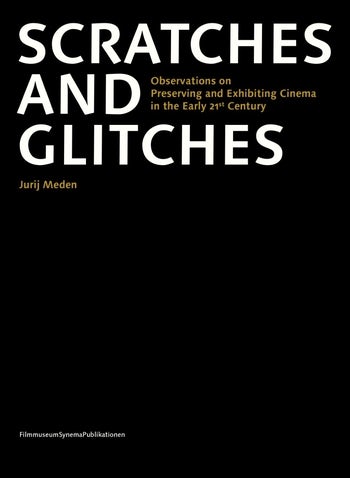Book review: ‘Scratches and Glitches: Observations on Preserving and Exhibiting Cinema in the Early 21st Century’ by Jurij Meden (Austrian Filmmuseum, 2021)

One often hears the lament, these days, that serious film publishing is in the doldrums. Some university presses have certainly abandoned this field – or, if they hold their ground, drive up the prices of academic books to kingdom come, so that effectively only wealthy libraries can afford them.
In another corner of the academic market, books – and, especially journals, which exist less and less in a physical form that anybody can buy, possess and collect – are digitally filleted into discretely sellable chunks, thus wasting whatever editorial coherence or unity they may have had at the outset.
I’m not a nostalgic type by nature, but one thing I do miss is the time – it lasted from the 1960s well into the ‘80s – when formidable books of film thought (by everyone from Parker Tyler and Molly Haskell to Victor Perkins and Raymond Durgnat) were marketed as cheap paperbacks, which got even cheaper when they filled the movie shelves of second hand bookshops. Those were the days!
But the good stuff still exists. In the 21st century, we just need to refocus our attention in order to find them – refocus to those modes and sites of publication that have long existed, but gradually taken centre stage. And I’m not even speaking (yet) of online websites, blogs and magazines. I am referring, rather, to the work of cinémathèques, summer schools and film festivals (sometimes in tandem with an established publisher, large or small) – as well as the brave new ventures that are trying to reclaim and regain the prominence and solidity of bound print (both books and magazines). Ruben Demasure keeps us all in line, in this regard, with his regular “New Book Releases” column appearing in Sabzian (https://www.sabzian.be/note/new-book-releases-spring-summer-2021).
2021 has been a great year for film books. In just a random sweep, I can cite I Am Independent: Beyond Mainstream – 7 Women Film Directors edited by Sung Moon for the Jeonju International Film Festival; the Fireflies series of “Decadent Editions” covering milestone films of the 2000s (three have appeared so far, by Erika Balsom, Nick Pinkerton, and Melissa Anderson); superb volumes from Capricci in France (including Mathieu Macheret on Josef von Sternberg, and Luc Moullet’s cheeky, maniacally detailed autobiography) as well as from a new player there, Marest; Douglas Dibbern’s imaginary ‘alternative history’ in Cinema’s Doppelgängers (punctum books); magnificent demonstrations of the enduring power of close analysis (following several different modes and philosophies) in George Toles’ Curtains of Light: Theatrical Space in Film (SUNY Press), Joe McElhaney’s Luchino Visconti and the Fabric of Cinema (Wayne State UP), D.A. Miller’s Second Time Around: From Art House to DVD (Columbia UP), and Hoi Lun Law’s Ambiguity and Film Criticism: Reasonable Doubt (Palgrave); and, last but far from least, Jurij Meden’s Scratches and Glitches courtesy of the Austrian Filmmuseum in Vienna, where the author works as a curator (I first met him in his days in Slovenia, 2008, when he co-edited the splendid Kino! magazine – which is still going, by the way).
The context of Meden’s professional vocation is of capital importance here. Michael Loebenstein’s Foreword informs us that the intensive writing of the book was a pandemic lockdown project – a “productive use of time”, indeed. It is presented as a series of short reflections – anecdotes, passing reflections, rather than “chapters” in the academic sense – that bear superb, wiggly titles like “The Subterranean Strata of the Film Economy or In Praise of the Celestial Cinematheque”.
The most wonderful thing about this book is its merry and entirely deliberate level of self-contradiction. Is the role of the curator today to preserve films in celluloid print form and maintain the sacred dispositif of theatrical projection in a dark room for a collective, mass audience? Of course it is! But, then again, this tallies neither with the reality of innumerable, interlocking ‘markets’ (sorry to use that word, but …), nor with the personal histories of so many militant cinephiles. Myself, for instance: without TV in the 1970s – still black-and-white for much of that decade in Australia – and cruddy old VHS tapes, indifferently scanned and bereft of all scholarly ‘extras’, in the 1980s – I would know infinitely less about some types of cinema I love. Not to mention the more recent cultural revolution of torrents and file sharing, and the more ambiguous advent of streaming …
Meden shoots back and forth between various positions, never settling on one or another as dogma. Yes, we must preserve, digitally scan the canonical masterpieces of Vidor, Fellini and Satyajit Ray at the highest possible ‘K’, work in collaboration with Criterion or Bologna’s Cinema Ritrovato or Scorsese’s World Cinema Project whenever possible … but that is a cultural sphere far removed from, for example, the heroic circulation, in many parts of the world, of Želimir Žilnik’s oeuvre in battered prints, dubbed cassettes, MP4 files, or whatever fragile support their remnants sit on.
I vividly recall the shock of director Raúl Ruiz and of myself in the midst of a solemn Parisian university seminar in 2006, when the clip from his Manoel on the Island of Marvels (1984) projected by a French student on the vast lecture-hall screen was clearly an nth-generation, DVD dub from the VHS video I had recorded off Australian TV sixteen years previously (the yellow subtitles and the accent of the announcer over the end credits were definite giveaway signs!). And the only trace of that amazing TV series which Raúl himself possessed, 22 years after making it, was the first copy I dubbed for him, from that very same Aussie videotape …
Everywhere, in all walks of life (as Meden reminds us), it is a matter of “prioritising scarce resources” – an often impossible balancing act. So, in the film culture sphere, we are always juggling massive inequalities that are going to lead to overdetermined decisions. Do we really need so many versions of Blade Runner – or, for that matter, Metropolis? The deadly mix of economic imperatives and taste hierarchies has, in advance, ruled out literally millions of individual films, filmmakers and genres from any likely “redemption” in any marketplace. But the game changes from day to day, and there are sudden moves that can surprise us …
Meden’s book covers a lot of lively ground beyond the strict perimeters of preservation and screening issues. It’s an exploration of many, varied facets of global film culture. It celebrates experimental artists whose ephemeral, explosive work could never be preserved, and was never meant to be. It mutilates certain sacred cinephile cows, like in the eye-opening section (“Re/Writing Film History, Part I or On the Shifting Nature of Values”) about the Navajo Indians’ unsung contribution to the films of the godhead John Ford, “exacting small acts of revenge on Hollywood racism”. By the same token, Meden is vigilant about trying to save films (and cinema) from emptily fashionable trends in groupthink journalism or social media frenzy. Criticism, curation, models of film history, shocking and/or liberatory moments in the everyday life of any cinephile … this is the expanded terrain of Scratches and Glitches. It is rare to encounter a book that is it once so charged and so concise, so free and so exact.
While composing this review, I encountered a fascinating piece by Jim Hoberman in the October 2021 issue of Artforum on the restoration and presentation of the experimental films of Neelon Crawford (now 75) – I confess that I had never heard of him before – at the Museum of Modern Art in New York. In it, Hoberman spends his concluding paragraphs worrying about the way in which Crawford the filmmaker has been (as he puts it) “reinvented as an artist”. He does not mean that Crawford has been re-evaluated, rediscovered or reappraised in some ethereal, qualitative sense, but rather he has been literally remade into an “image-maker” – no longer strictly a filmmaker – whose work can be packaged and presented within gallery/museum contexts: on monitors, in still images, and so on.
Digital restoration of the original, often fragile film materials has, naturally, provided the key step in this material makeover. It has also brought in its wake a riot of what Hoberman refers to as “ontological” (or definitional) problems and difficulties. When film clips on LED monitors are included in exhibitions, for instance, are they “intended to be seen as actual artworks, as copies, or as historical annotations on the ‘real’ art on the wall”? It’s not only MoMA shows that raise this question, but also several major exhibitions curated by Dominique Païni such as Art and Film, 120 Years of Exchange (installed at Caixa Forum in Barcelona and Madrid 2016-2017). In relation to the case of Crawford, Hoberman ruminates:
Filmmaking enforces a regimen of pragmatism, and most filmmakers and film curators have come to terms with the reality of digital exhibition (and now distribution), although some do prefer to work on film and to project films as films. It would be unrealistic to complain that MoMA is not showing Crawford’s films as they were originally intended to be shown. But it is also unrealistic to pretend that certain material qualities are not lost.
It is on the horns of that very dilemma – artistic, ethical, political – that Jurij Meden’s Scratches and Glitches dances. And perhaps, in 2021, we are all, in a global sense, dancing our way to Hell or the abyss, anyhow. While these things still matter to us, however, Scratches and Glitches is an urgently important and fun book. Read it while you still can.
© Adrian Martin, October 2021
















